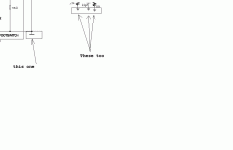The symbols on the right prabably represent the ground trace on a printed circuitboard. The symbol at the left is where the circuitboard ground connects to the chassis.
Those symbols represent ground or circuit common. There are various ways to draw it, so it may look different in one company's drawings than another's.
The flat line is one, and the upside down pyramid too. Those are what you presented. Ther is also one that looks like a garden rake.
Though we may call it ground, in a battery operated circuit, there may not be an actual connection to ground. it is then simply called the "common" connection. In some parts of the world, they refer to ground as "earth" in the sense that it ultimately connects to something conducting to the actual earth outside.
The flat line is one, and the upside down pyramid too. Those are what you presented. Ther is also one that looks like a garden rake.
Though we may call it ground, in a battery operated circuit, there may not be an actual connection to ground. it is then simply called the "common" connection. In some parts of the world, they refer to ground as "earth" in the sense that it ultimately connects to something conducting to the actual earth outside.
It's a variable resistor, or potentiometer, usually abreviated to 'pot'. In the Wah pedal you linked it is the resistor that controls the wah function, and is usually mechanically geared off the pedal lever itself. The same type of device is used in just about all rotary controls on electronic instruments, such as volume controls etc. The long linear channel gains on mixing desks, and the sliders on graphic equalisers are identical in function, it's just that the control moves physically in a different way, ie linear rather than rotationally.brentt said:Thanx for helping me out with that but now im not sure on another component. Ill add a pic....
Hotz Potz is a brand name for the part.
- Status
- Not open for further replies.

